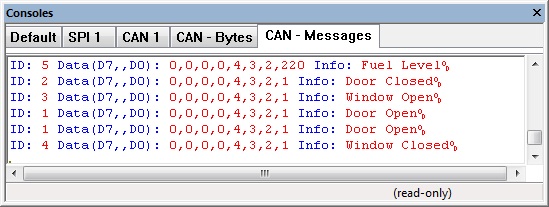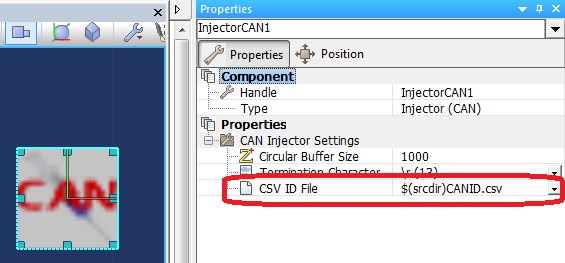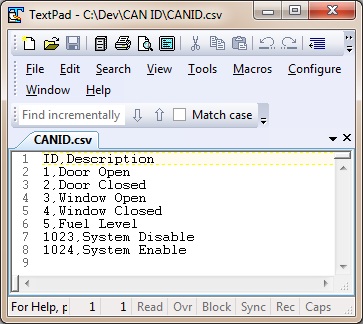Difference between revisions of "Component: Injector (CAN) (Simulation)"
(XML import) |
(XML import) |
||
| (2 intermediate revisions by 2 users not shown) | |||
| Line 4: | Line 4: | ||
|- | |- | ||
| width="20%" style="color: gray;" | Author | | width="20%" style="color: gray;" | Author | ||
| − | | | + | | Matrix Ltd |
|- | |- | ||
| width="20%" style="color: gray;" | Version | | width="20%" style="color: gray;" | Version | ||
| − | | 1.0 | + | | 1.0 (Release) |
|- | |- | ||
| width="20%" style="color: gray;" | Category | | width="20%" style="color: gray;" | Category | ||
| Line 22: | Line 22: | ||
==Examples== | ==Examples== | ||
| − | + | The CAN component works together with the injector component to allow you to decode a CAN message ID into a meaningful command. | |
| + | |||
| + | Example File | ||
| + | {{Fcfile|CAN_Demo.fcfx|CAN_Example1}} | ||
| + | When a key on the keypad is pressed the CAN components transmits a CAN packet. | ||
| + | |||
| + | The CAN packet is decoded by the injector component to give us a meaningful log on the console window. | ||
| + | |||
| + | |||
| + | High Level CAN Data Console | ||
| + | |||
| + | [[File:CAN_High.jpg]] | ||
| + | |||
| + | |||
| + | Low Level CAN Data Console | ||
| + | |||
| + | [[File:CAN_Low.jpg]] | ||
| + | |||
| + | |||
| + | Reference from CAN Injector to ID decode file, $(srcdir) refers to the current project directory. | ||
| + | |||
| + | [[File:CAN_File.jpg]] | ||
| + | |||
| + | |||
| + | Demo CAN ID file [[File:CANID.csv]] | ||
| + | |||
| + | [[File:CAN_DataFile.jpg]] | ||
==Downloadable macro reference== | ==Downloadable macro reference== | ||
| Line 32: | Line 58: | ||
''This component inherits simulation macros from ''[[Component: ID cc936c18_5d20_42c4_b940_d3c7ea7ca802|Data Injector]] | ''This component inherits simulation macros from ''[[Component: ID cc936c18_5d20_42c4_b940_d3c7ea7ca802|Data Injector]] | ||
| + | |||
| + | ===<span style="font-weight: normal;"><u><tt>InitialiseInjector</tt></u></span>=== | ||
| + | Sets up the injector ready to receive commands or send data | ||
| + | |||
| + | '''Parameters''' | ||
| + | |||
| + | :[[Variable Types|<- STRING]] ''InjectorName'' | ||
| + | ::Name of the console that will be created | ||
| + | ::''This parameter may be returned back to the caller'' | ||
| + | |||
| + | |||
| + | '''Return value''' | ||
| + | |||
| + | :[[Variable Types|BYTE]] | ||
| + | |||
===<span style="font-weight: normal;"><u><tt>TxByte</tt></u></span>=== | ===<span style="font-weight: normal;"><u><tt>TxByte</tt></u></span>=== | ||
| Line 109: | Line 150: | ||
:[[Variable Types|HANDLE]] | :[[Variable Types|HANDLE]] | ||
| − | |||
| − | |||
| − | |||
| − | |||
| − | |||
| − | |||
| − | |||
| − | |||
| − | |||
| − | |||
| − | |||
| − | |||
| − | |||
| − | |||
| − | |||
Latest revision as of 11:25, 13 February 2015
| Author | Matrix Ltd |
| Version | 1.0 (Release) |
| Category | Simulation |
| This inherits from Data Injector | |
Contents
 Injector (CAN) component
Injector (CAN) component
Comms data injector to allow CAN message identifiers to be decoded to specific message strings. Uses an external CSV file to specify the IDs and descriptive strings.
Examples
The CAN component works together with the injector component to allow you to decode a CAN message ID into a meaningful command.
Example File
![]() CAN_Example1
When a key on the keypad is pressed the CAN components transmits a CAN packet.
CAN_Example1
When a key on the keypad is pressed the CAN components transmits a CAN packet.
The CAN packet is decoded by the injector component to give us a meaningful log on the console window.
High Level CAN Data Console
Low Level CAN Data Console
Reference from CAN Injector to ID decode file, $(srcdir) refers to the current project directory.
Demo CAN ID file File:CANID.csv
Downloadable macro reference
This component does not contain any downloadable macros
Simulation macro reference
This component inherits simulation macros from Data Injector
InitialiseInjector
Sets up the injector ready to receive commands or send data
Parameters
- <- STRING InjectorName
- Name of the console that will be created
- This parameter may be returned back to the caller
Return value
TxByte
Puts a byte onto the comms channel.
CAN packet is inserted into injector like this:
ID3, ID2, ID1, ID0, D7, D6, D5, D4, D3, D2, D1, D0, \n
Parameters
- BYTE DataByte
Return value
- This call does not return a value
RxByte
Attempt to receive a byte back from the injector
This call is provided by Data Injector
Parameters
- This macro has no parameters
Return value
GetTxConsoleHandle
Gets the handle to the console allowing data displaying on the panel etc.
This call is provided by Data Injector
Parameters
- This macro has no parameters
Return value
ChangeState
Changes the state for I2C or SPI type comms where the data bytes along are not enough to go on.
This call is provided by Data Injector
Parameters
- BYTE NewState
- Assigns new state, 0=default
Return value
- This call does not return a value
GetRxConsoleHandle
Gets the handle to the console allowing data displaying on the panel etc.
This call is provided by Data Injector
Parameters
- This macro has no parameters
Return value
GetConsoleHandle
Gets the handle to the console allowing data displaying on the panel etc.
Parameters
- BYTE HandleIndex
- Selects which console handle to obtain - 0=ID/Data 1=ID Meanings
Return value
Property reference
Circular Buffer Size
This property is of type Unsigned integer and can be referenced with the variable name CircularBufferSize.
Number of bytes that can be held in the injector's circular buffer
Termination Character
This property is of type Fixed list of ints and can be referenced with the variable name TermChar.
Used to signify the end of a message, in the case of CAN it will end a specific identifier message
CSV ID File
This property is of type Filename and can be referenced with the variable name CSVFile.
Location of comma seperated ID description file.
e.g.
ID,Description
1,Door Open
2,Door Closed
3,Window Open
4,Window Closed
1023,System Disable
1024,System Enable



